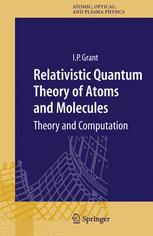

Most ebook files are in PDF format, so you can easily read them using various software such as Foxit Reader or directly on the Google Chrome browser.
Some ebook files are released by publishers in other formats such as .awz, .mobi, .epub, .fb2, etc. You may need to install specific software to read these formats on mobile/PC, such as Calibre.
Please read the tutorial at this link: https://ebookbell.com/faq
We offer FREE conversion to the popular formats you request; however, this may take some time. Therefore, right after payment, please email us, and we will try to provide the service as quickly as possible.
For some exceptional file formats or broken links (if any), please refrain from opening any disputes. Instead, email us first, and we will try to assist within a maximum of 6 hours.
EbookBell Team

4.8
94 reviewsThis book presents a unified approach to modern relativistic theory of the electronic structure of atoms and molecules which will provide experimental and theoretical scientists and graduate students with a range of powerful computational tools for a growing range of physical, chemical, technological and biochemical applications. Starting from its foundations in quantum electrodynamics, the book contains a careful account of relativistic atomic and molecular structure based on Dirac's relativistic Hamiltonian, and the numerical algorithms implemented by modern computer programs. The relativistic atomic structure code GRASP, which can compute atomic energy levels, radiative transition rates and other atomic properties using the multiconfigurational Dirac-Hartree-Fock or relativistic configuration interaction methods, is reviewed along with the relativistic R-matrix code DARC, which is used for the high precision modelling of the interactions of atoms and ions with photons and electrons. The recently developed BERTHA relativistic molecular structure code, the first to exploit fully the symmetry properties of Dirac 4-component spinors, provides a new resource for studying the properties of molecules, atomic clusters and other materials, especially those containing heavy elements for which a relativistic model is essential.